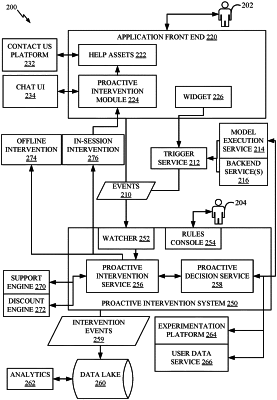| CPC G06Q 30/016 (2013.01) [G06F 9/453 (2018.02); G06N 20/00 (2019.01); G06Q 30/0224 (2013.01)] | 14 Claims |

|
1. A method for proactive intervention in a software application, comprising:
providing, by a proactive intervention system related to an application, event information of a plurality of events as inputs to a first machine learning model, wherein:
the event information comprises clickstream data related to use of the application and contextual information associated with the plurality of events;
the contextual information comprises user attributes; and
the first machine learning model has been trained through a supervised learning process to recognize that certain events are correlated with users abandoning use of the application;
receiving, from the first machine learning model in response to the inputs, abandonment confidence scores for the plurality of events, wherein each of the abandonment confidence scores indicates a likelihood that a user will abandon the application;
assigning, by the proactive intervention system, priorities to the plurality of events based on the abandonment confidence scores;
selecting, by the proactive intervention system, an event of the plurality of events for processing based on the priorities assigned to the plurality of events;
providing, by the proactive intervention system, one or more inputs to a second machine learning model, the one or more inputs including the event information and the abandonment confidence scores, wherein the second machine learning model has been trained through a supervised learning process by which parameters of the second machine learning model were iteratively adjusted based on a training data set comprising attributes of historical events associated with labels indicating that certain proactive interventions are relevant to the historical events;
determining, by the proactive intervention system, a proactive intervention based on a proactive intervention confidence score with respect to the proactive intervention that is output by the second machine learning model in response to the one or more inputs;
determining, by the proactive intervention system, that the proactive intervention can presently be provided based on intervention availability data;
providing, by the proactive intervention system, the proactive intervention via a user interface associated with the application;
receiving user feedback with respect to the proactive intervention, wherein the second machine learning model is re-trained based on the user feedback to generate a re-trained second machine learning model; and
using the re-trained second machine learning model to determine a subsequent proactive intervention.
|